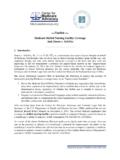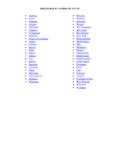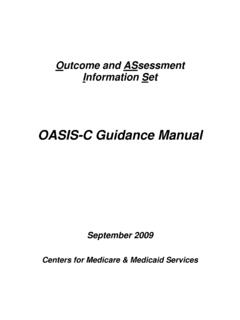Transcription of Observation Stays Fact Sheetact Sheet
1 Observation Sta ys Fact SheetObservation Sta ys Fact SheetSUPPORTED BYMedicare beneficiaries are being denied access to Medicare s skilled nursing facility (SNF) benefit because of the way hospital sta ys are Medicare law, patients must have an inpatient s ta y in a short-t erm acute care hospital spanning at least three days (not counting the day of discharge) in order for Medicare to pay for a subsequent sta y in a SNF. However , under current Medicare rules, acute care hospitals are increasingly holding patients under Observation , an outpatient designation, rather than admitting them as inpatients. Outpatients may sta y for many days and nights in hospital beds and receive medical and nursing care , diagnostic tes ts, tr eatments, medications, and food, identical to that of inpatients. As a result, although the care received by patients in Observation sta tus is the same medically neces sary care rec eived by inpatients, outpatients who need follow-up care do not qualify for Medicare cover age in a SNF.
2 Hospital sta ys classified as Observation , regardless of their length and the type or number of services provided, are considered outpatient. These outpatient hospital sta ys, even if they span sever al days, do not qualify patients for Medicare-cover ed care in a SNF; only inpatient time use of Observation sta tus and the amount of time patients spend in Observation sta tus are both increasing. An early study1 f ound a 34% increase in the ratio of Observation sta ys to inpatient admissions between 2007 and 2009, leading the researchers to conclude that outpatient Observation sta tus was increasingly becoming a substitute for inpatient sta tus. The same study also documented increases in long-sta y outpatient sta tus, including an 88% increase in Observation Stays exceeding 72 hours. A 2013 report by the least three days, but that did not include three inpatient days. The pattern continued. In December 2016, the Inspector General reported that 748,337 long hospital sta ys wer e called outpatient, including 633,148 outpatient sta ys of three or more days, in FY 2014.
3 Between FYs 2013 and 2014, outpatient sta ys increased by , despite implementa tion of the two-midnight rule (see rever se side of document) that was expected to decrease outpatient sta ys. Support for counting time spent in Observation sta tus towar d the three-day prior inpatient sta y continues to grow: The Inspector General s 2013 report was supportive of counting Observation days towar ds the three-day inpatient sta y requirement. In September 2013, the Congres sionally-created Long Term Car e Commission recommended that the Center s for Medicare & Medicaid Services (CMS) count time spent in Observation sta tus towar d meeting the three-day sta y requirement. In 2015, the Medicare Payment Advisory Commission (MedPAC) explored various policy options for counting time spent in Observation towar d meeting the SNF 3-day Commission unanimously recommended that CMS revise the SNF 3-day rule to allow for up to two outpatient Observation days to count t owar d meeting the requirement, recognizing that beneficiaries are needlessly facing barriers to acces sing needed post- acute Improving Access to Medicar e Coverage Act of 2017 c ounts the time Medicare beneficiaries spend in Observation towar d the three-day sta y requirement, so that Medicare patients who spend three days in a hospital, regardless of inpatient/ Observation designation, are able to access post- acute care in a SNF when they need re-introduced this Congress with bipartisan support would create a full and permanent solution.
4 The Improving Access to Medicare Coverage Act of 2017 (S. 568 1421), sponsored by Representatives Joe Courtney (D-CT) and Glenn GT Thompson (R-PA) and Senators Sherrod Brown (D-OH), Susan Collins (R-ME), Bill Nelson (D-FL), and Shelley Moore Capito (R-WV) would help Medicare beneficiaries who are hospitalized in Observation by requiring that time spent in Observation be counted towards meeting the three-day prior inpatient Medicare Payment Advisory Commission (MedPAC), June 2015 Report to Congres Association of Directors of Nursing ServicesAAHAMA merican Association of Healthcare Administrative ManagementAANACA merican Association of Nurse Assessment CoordinationAARP ACMAA merican Case Management AssociationAging Life care AssociationAHCAA merican Health care AssociationAJASA ssociation of Jewish Aging ServicesAlliance for Retired AmericansAmerican College of Emergency PhysiciansAmerican Medical AssociationAMDAThe Society for Post- acute and Long-Term care MedicineCenter for Medicare AdvocacyThe Coalition of Geriatric Nursing OrganizationsEmergency Nurses AssociationThe Hartford Institute for Geriatric Nursing The Jewish Federations of North America Justice in AgingLeadership Council of Aging Organizations LeadingAgeLSAL utheran Services in AmericaMedicare Rights Centern4aNational Association of Area Agencies on AgingNAELA National Academy of Elder Law Attorneys.
5 Association of Health care AssistantsNASLN ational Association for the Support of Long Term CareNASOPN ational Association for State Long-Term care Ombudsman ProgramsNCAL National Center for Assisted LivingNCHCN ational Coalition on Health CareNational Committee to Preserve Social Security & MedicareThe National Consumer Voice for Quality Long-Term CareSHMS ociety of Hospital MedicineSpecial Needs Alliance Zhanlian Feng, Brad Wright and Vincent Mor, Sharp Rise In Medicare Enrollees Being Held In Hospitals For Observation Raises Concerns About Causes And Consequences, 2 APTAA merican Physical Therapy AssociationThe NOTICE Act, while a step in the right direction, does not go far enough to ensure patients have access to needed post- acute care into law in August 2015, the NOTICE Act r equires hospitals to inform patients who are rec eiving outpatient Observation services for more than 24 hours that they are outpatients, not inpatients. Hospitals and critical access hospitals had to begin using the Medicare Outpatient Observation Notice (MOON) no later than March 8, 2017.
6 While rec eiving written and oral notice informs patients of their sta tus, the law although a positive step forwar d does not give patients hearing rights or count the time in the hospital for purposes of SNF coverage. The OIG recently found that a new rule intended to slow the growth in long outpatient sta ys the so-called two-midnight rule does not eliminate, and in fact has exacerbated, the barriers beneficiaries face in accessing needed post- acute care the 2-Midnight Rule WorksIn October 2013, CMS adopted the two-midnight rule , which establishes time-based criteria for physicians to use when deciding to admit a patient as an inpatient or keep them under outpatient Observation . The rule sta tes that f or patients expected to require hospital services for at least t wo midnights, inpatient admission will be presumed appropriate for payment. Likewise, f or patients expected not t o require hospital services for at least t wo midnights, outpatient Observation is presumed appropriate.
7 The rule was intended to give admitting physicians additional assurance that their decision to admit would not be questioned by auditor s, thereby reducing the incidence of long outpatient sta ys. CMS intended the two-midnight rule to decrease the number of long outpatient sta ys and decrease the number of short inpatient the OIG FoundIn a December 2016 report3, the OIG found that since the implementa tion of the two-midnight rule, t otal outpatient sta ys have increased and total inpatient sta ys have decreased the opposite of CMS expecta tions exac erbating an already challenging problem. It is now clear that while CMS in tended to fix the problem through implementa tion of the two-midnight rule, it has inadvertently wor sened the situation for thousands of beneficiaries who are unable to access needed post- acute care . The report rec ommends that CMS analyze the potential impacts of counting time spent in as an outpatient t owar d meeting the SNF three-day requirement so that beneficiaries rec eiving similar hospital care have similar acces s to post- acute care the rule and its revision reflect CMS c oncerns about long outpatient sta ys, hospitals are unlikely to change their practices when CMS provides no meaningful guidance on when an inpatient sta y of fewer than two midnights is appropriate.
8 Physician decisions about patient sta tus continue to be reviewed by hospitals under the same standards as befor e: short inpatient decisions are prioritized for review by Quality Improvement Organizations (QIOs); and the specter of audits by Rec overy Auditor s (still known as RACs) r emains. The mission of the RACs is to identif y and correct Medicare and Medicaid improper payments. A RAC s determination that a patient has been incorrectly classified as an inpatient r equires the hospital to return most of the Medicare reimbursement f or the patient s sta y, despite the fact that the services wer e medically neces sary and cover able by Medicare. Rec ently-imposed penalties for readmitting a hospital patient within 30 days increase hospitals motivation to classify patients as outpatients, rather than










